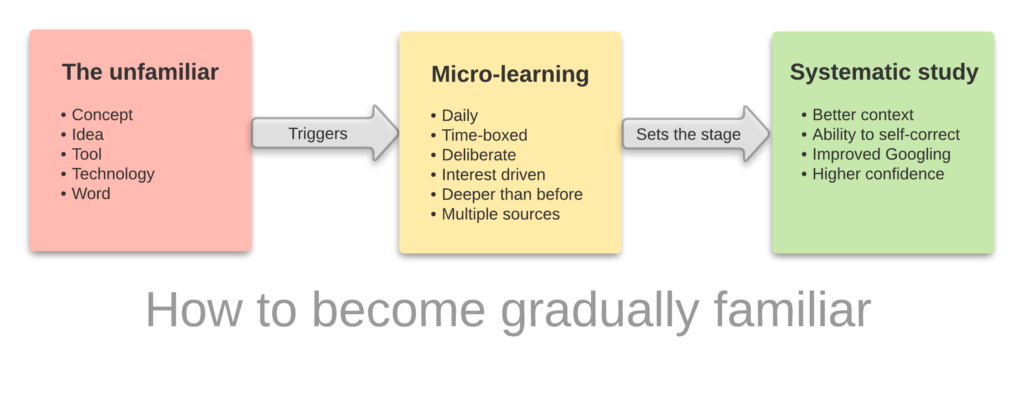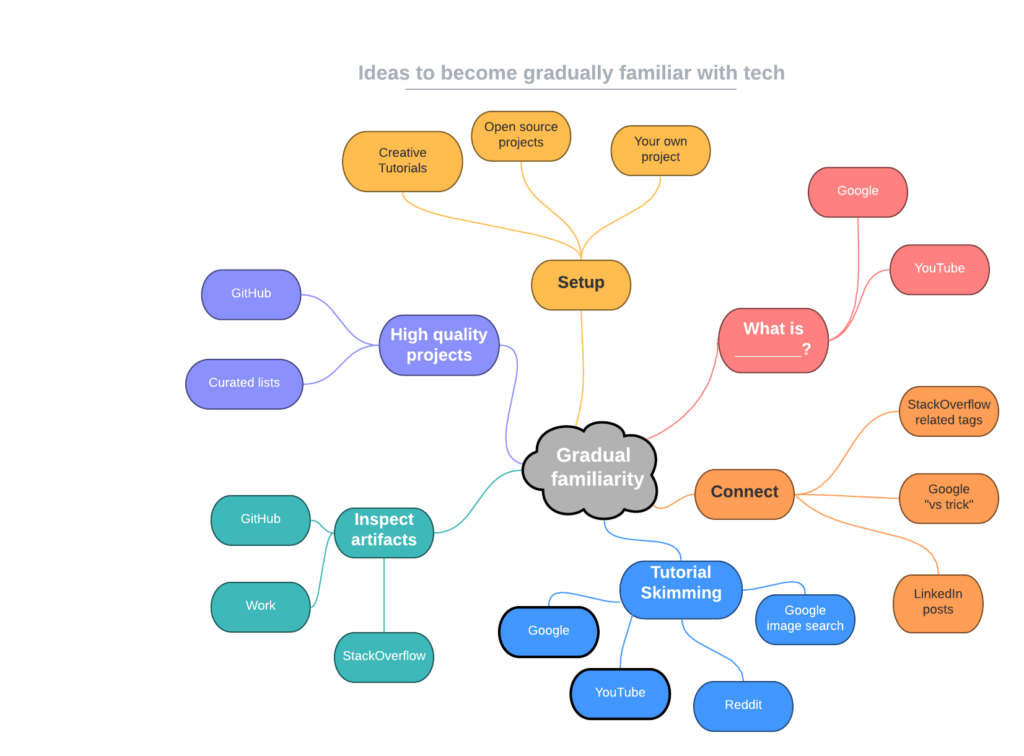Most QA jobs offer daily opportunities to learn new things every day. Yeah, even the job you are at right now! We get introduced to new technologies and ideas that our colleagues work on. News about our competitors trickles in. We hear things during water-cooler conversations with coworkers. Our colleagues share interesting articles about technology. And so on. But we tend to get busy and ignore these opportunities to gradually become familiar with new topics. We tell ourselves
Trying to learn new stuff properly takes a lot of time. Each of these topics I hear about is probably going to take months to study. Where am I supposed to find the time? I have enough on my plate already!
This article lists some practical ideas that you can implement in less than 10-minutes a day. These techniques will ensure you are learning something new every day at work.
NOTE: This article was originally written for the now defunct Senior QA Training program conducted by Qxf2. This is a non-technical article. If you are a regular consumer of our technical work, please skip reading this article..
When learning new technologies and tools, try gaining gradual familiarity before you attempt deep learning. Everytime you hear a technical word that you do not know all that well, use it as a learning trigger. Learn just a little bit more about the technolgy or tool. This way, you can get a much better conceptual understanding of the technology or tool before you dive deep.

Unknown, Unfamiliar, Un-whatever
You might be telling yourself that you religiously Google every unknown word you hear. Well, the Google results simply takes something unknown to you and makes it unfamiliar to you. There is more work to do!

I am listing out several ideas to get gradually familiar with new technologies and tools. You might already be doing most of these suggestions but probably not in a systematic way. Each time you hear an unfamiliar word, dig just a little deeper. Every time you hear a tech or tool, pick anyone of the below points and try it out. Do not stop at where you are comfortable – go deeper than you are used to. And definitely time-box your attempts to 10-minutes and no more!
To play along, imagine $tech is the word that you do not know.
Stage 1: What is ________
The first time you hear a new word (say $tech) – Google it immediately! Suggested search strings are $tech, what is $tech, $tech explained, etc. There are several good YouTubers who explain technology in plain words. Bonus – you might get to learn in your own mother tongue!
Stage 2: Make connections
The next few times you come across the same word, start making connections with $tech and other stuff you know. This helps you develop a better mental map of technologies that are being used. As your mental map expands, it will help you assimilate newer tech much easier. StackOverflow has a ‘related tag’ feature that is useful. You can also rely on Google search’s autocomplete feature to see what other tech are related. Simply type ‘$tech vs ‘ and autocomplete will suggest relevant alternatives. You can also look through LinkedIn hashtags to see what the tech world associates with
Stage 3: Tutorial skimming
Look for practical tutorials. Skim! Do not actually try out the tutorials. The goal is to cultivate familiarity with the vocabulary and patterns before you become hands on. Remember to use Google image search, reddit and YouTube in addition to just blog posts. The image search will usually turn up nice block diagrams and give you some conceptual understanding. Reddit and YouTube have much higher quality tutorials shared than Google search results. Some example searches are: – $tech + hands on, $tech + fundamentals, $tech + for beginners, $tech + beginner tutorial, $tech + practical tutorial, $tech + Quick start, etc.
Stage 4: Inspect artifacts
Look at the implementation – or talk to someone at work. Examine the artifacts. Do not feel disheartened if you do not know what the artifacts mean. Professionals are going to produce something more complex than tutorials. GitHub search and your workplace are the best places to look for artifacts. GitHub search is an under-rated tool. On GitHub, try searching for a “$tech working example”. Similarly you can use StackOverflow search – to get your vocabulary right. Try to keep an eye out for the words people use to describe doubts they have with $tech. Look for setup issues with $tech. All these are 10-minute activities that will lay the foundation for you to build upon when the time comes.
Stage 5: High quality projects
Look around for high quality projects for $tech. You might need to sign up for newsletters or search for curated lists of $tech. Inspecting high quality projects in $tech will help you understand the tool belt associated with $tech. It will also help you start recognizing practical patterns of usage of $tech. For example, you might notice the different ways in which open source projects that use $tech organize their tests.
Stage 6: Set up stuff yourself!
Before you actually try a project out using $tech, mentally make setup (e.g.: install) as a separate step. Too many beginners struggle to setup tools correctly and then think that they suck at using the tool. So until you can fly through installs, keeping setup as a separate step serves as a useful trick to disassociate setup from actual use of a tool.
Words of caution
1. These approaches are good for technologies and not really for learning ‘fields’ or ‘areas’. So think learning ‘Ansible’ and not learning ‘DevOps’. Think learning ‘kNN algorithm’ and not ‘machine learning’.
2. For this technique to have a chance at succeeding, you should suppress your inner voice that constantly asks you if what you are learning is useful to you.
3. Time boxing is key. Do not skip the ’10-minute time box’ part of the exercise. The time box is critical in training your brain to learn in smaller pieces but more often. It is ok to not produce anything in the time-box for the first few weeks. But just like any other daily habit, your brain will get better at processing information quicker.
Why this approach might work for you
One, it is much easier to find a dozen chunks of 10-minutes rather than sit for two hours uninterrupted.
Two, you feel more confident when trying your first hands on exercise. Your brain is already familiar with some of the terms. You are also confident that if you hit issues, you can probably switch exercises or Google for solutions with the right terms. You are better prepared to tackle errors because you know enough vocabulary to frame your questions. You know enough to isolate the topic from other topics – a major benefit when you hit errors.
Three, your brain has time between learning sessions to make connections, figure out what is important, forget what is not, etc. This mode of the brain is apparently called ‘diffuse mode’ and is essential to learning. I do not know much about the brain, so this point is just hearsay based on the famous Coursera course ‘Learning how to learn’.
Four, this sort of deliberate, daily, micro-learning is going to seem familiar. Almost all the significant learning you have done in your life took this route. You learnt your first language like this. You learnt being a functioning member of family, society, school and work like this. Any hobby you are good at happened this way. And if you are a tester, I bet you did not learn testing in one semester from text books. You picked up testing gradually but daily.
Starting this habit is the hardest part
Do this sort of deliberate micro-learning for the next several months even if it seems like a waste of time. If you stick to this habit, you will notice that you have begun to become more comfortable with the new and unknown. You will also have more hooks to help you store, connect and synthesize new information. When you stick to this process, you will notice that knowledge has this compounding effect. A larger knowledge base will help you will pick up new things much quicker.
This post outlines some advice for increasing your technical exposure. It advocates practicing some deliberate micro-learning on a daily basis. There are several ideas (quick to execute!) you can try to keep your learning fresh. Hopefully, trying some of these ideas makes your learning a bit more fun!
I want to find out what conditions produce remarkable software. A few years ago, I chose to work as the first professional tester at a startup. I successfully won credibility for testers and established a world-class team. I have lead the testing for early versions of multiple products. Today, I run Qxf2 Services. Qxf2 provides software testing services for startups. If you are interested in what Qxf2 offers or simply want to talk about testing, you can contact me at: [email protected]. I like testing, math, chess and dogs.
